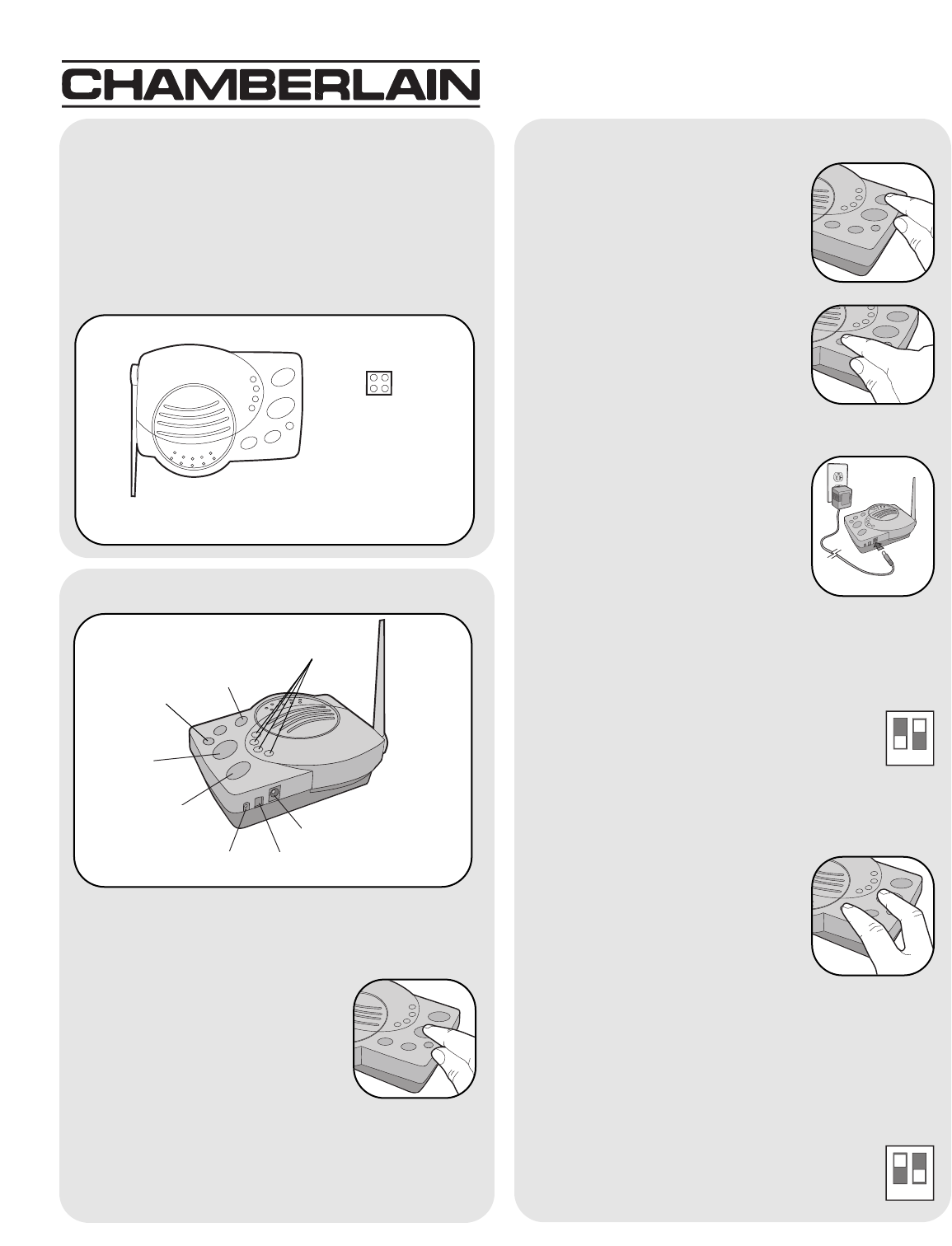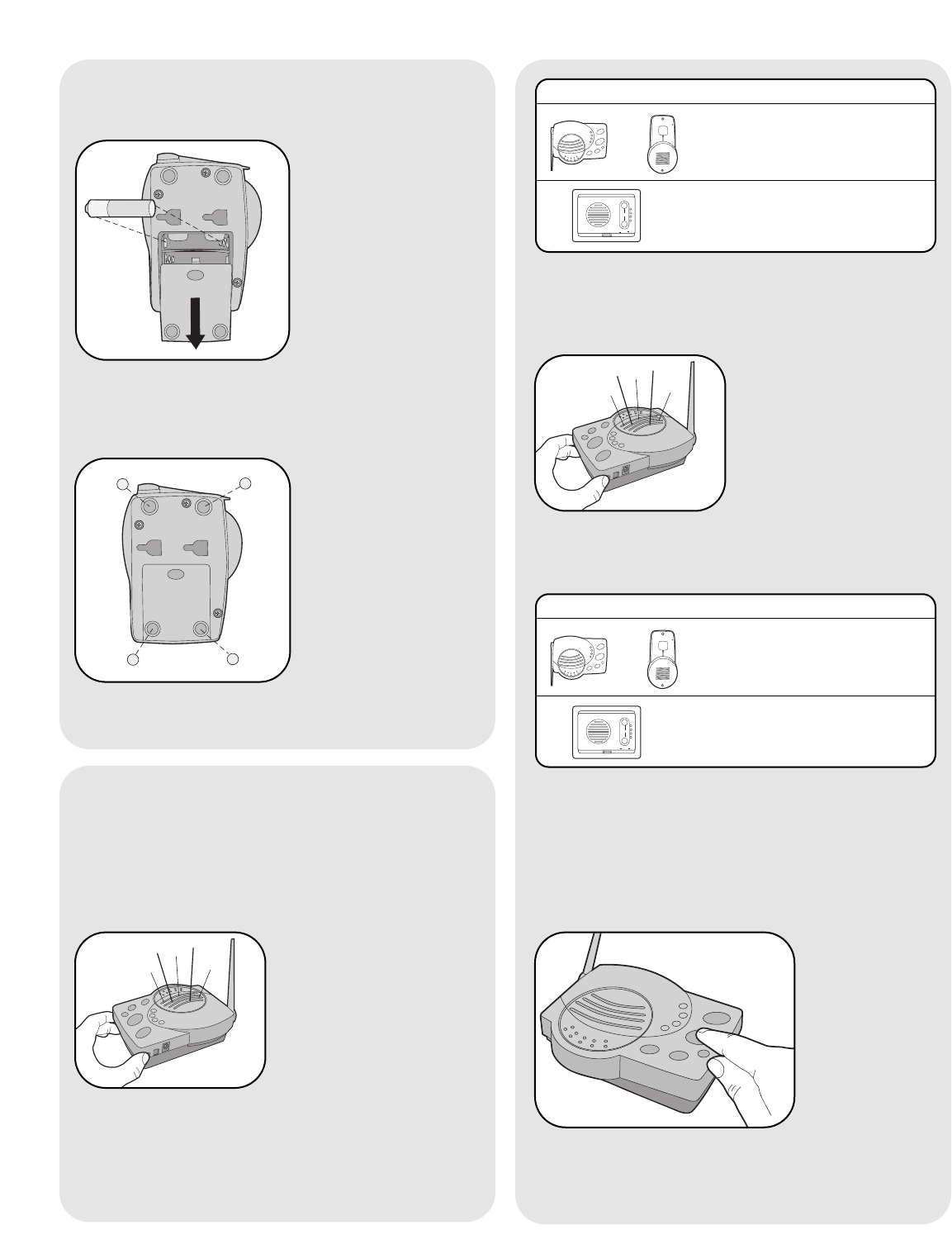Chamberlain Wireless TRX1 Wireless Portable Intercom User Manual
Chamberlain Wireless Products Inc. Wireless Portable Intercom
User Manual

Carton Inventory
Overview
The Intercom has up to a 1000' range and allows
multiple simultaneous conversations, using a
900 Mhz secure digital radio link. The intercoms form
an exclusive network and respond only to other
intercoms in the network.
Intercom (2 in Model RWIS)
1
Rubber Pads
(2 in Model RWIS)
Operation & Features
Channel Button: Press the Channel button to set
intercom to one of four secure
channels or the paging channel.
The default channel for the intercom
is the paging channel where all four
channel lights are lit. An intercom on
a channel can only hear an
intercom on the same channel or on
the paging channel.
Volume: Pressing the Volume
button repeatedly will cycle through
volume levels.
Battery: The AA Alkaline batteries (not provided) will
last up to a year depending on use (Lithium batteries
recommended for colder
environments). When batteries are
low intercom will emit two beeps
every ten minutes.
An AC Adapter (not provided) can
also be used to power the intercom.
In this case, both the power and
channel lights will remain on.
Conference Mode: Conference Mode allows multiple
intercoms to participate in a conversation compared
to Normal Mode in which only two intercoms can
communicate. All intercoms must be set to the same
channel or the paging channel to be in
Conference Mode. To put intercom in
Conference Mode set Dipswitch #2 to UP
position.
Monitor Mode: Monitor Mode is used to monitor the
noise in a specific room. Place the intercom in the
room that is to be monitored and
press and hold the Talk and Volume
buttons until a tone is heard. Any
other networked intercom can listen
to that room. If a specific channel is
selected for Monitor Mode then only
other intercoms on that channel or
on the paging channel can listen.
Voice Activation Mode (VOX): Voice Activation
Mode (VOX) allows a call to be answered without
pressing the Talk button. Once a call is heard on an
intercom which has been set to VOX, a response can
be given by speaking loudly into the intercom. There
will be a slight delay when VOX is first activated by a
voice, but will continue to transmit audio until
the speaking stops. To put intercom into VOX,
place Dipswitch #1 to the UP position.
On/Off: To turn intercom ON, press any button.To
turn intercom OFF, hold down the Volume button for
5 seconds.
Talk Button: To talk, hold down the
Talk button. All intercoms in the
network that are on the same
channel will receive the signal.
Release the Talk button when done
talking and within 10-15 seconds
press and hold the Talk button of a
different intercom to make a secure channel between
the two. Once the channel is made the other
intercoms in the network cannot hear the
conversation.
Volume Button
Talk
(Power - On)
Channel Button
Learn Button Dipswitch #1
Dipswitch #2
AC Adapter
Model RWIA & RWIS
Wireless Portable Intercom
®
OPTIONAL
12
12
Microphone
Channel Lights

2
Assemble Intercom
Step 1
Step 2
Install 4 AA Alkaline batteries (not provided). (Lithium
batteries recommended for colder environments.)
Programming Intercom
Adhere rubber pads to bottom.
Repeat Steps 1 and 2 for any additional intercoms.
The intercom must be programmed to at least one
other intercom to become a network or it can be
programmed into an existing network.
Create New Network
Press the Learn button on the new intercom until a
beep is heard. Within 10 seconds put the second
intercom into Learn Mode (refer to the following
table).
Add to an Existing Network
Press the Learn button on the new intercom until a
beep is heard. Within 10 seconds put any networked
intercom into Learn Mode (refer to table below).
Press and release the Talk button to verify network is
complete.
INTERCOM LEARN MODE
Press the Learn button until
a beep is heard.
Press and hold both buttons
for 5 seconds.
OR
Each intercom will emit a tone when programmed into
network. Repeat for any additional intercoms.
Each intercom will emit a tone when programmed into
network. Repeat for any additional intercoms.
NOTE: Do not program new intercoms to each other
before adding them to the network or they will form a
separate network and the memory will need to be
cleared.
INTERCOM LEARN MODE
Press the Learn button until
a beep is heard.
Press and hold both buttons
for 5 seconds.
OR

Troubleshooting
3
Intercom does not function.
Check batteries in intercom. If using an AC Adapter
ensure that it is plugged in.
Ensure intercom is connected to a network.
See Programming Intercom.
Ensure that intercoms are on the same channel. See
Operation & Features.
Intercom is not getting expected transmission
range.
Keep antenna vertical. Keep intercom away from
trees, metal objects and electrical wiring. Cell phones,
cordless phones, or other radio devices may also
limit range.
Intercom beeps every ten minutes.
The battery is low in the intercom. Replace with AA
Alkaline batteries or operate it with AC Adapter (not
provided). A 9-12 volt, 500mA AC Adapter may be
used (center positive polarity on the round plug).
Need to clear intercom’s memory.
Press and hold Learn button, an initial beep will be
heard. Continue to hold until a second beep is heard
(about 15 seconds). Ensure other intercoms are not
activated during this time. Intercoms in the network that
are on will signal during the clearing process. Once
memory is clear the intercom can be programmed to a
new network.
Static and feedback is heard in intercom.
The intercoms are too close to each other. A cordless
phone, cell phone, or other radio devices can also
cause static.
Intercom is sending audio while no buttons are
pressed.
The sending intercom is set to Monitoring Mode or Voice
Activation Mode and will activate when sound is heard.
It can be taken out of Monitoring Mode by pressing the
Talk button. It can be taken out of Voice Activation Mode
by setting Dipswitch #1 to DOWN position.
See Operation & Features.

© 2007, The Chamberlain Group Inc.
114A3510 All Rights Reserved
NOTICE: To comply with FCC and or Industry Canada rules (IC), adjustment or modifications of this
receiver and/or transmitter are prohibited, except for changing the code setting or replacing the battery.
THERE ARE NO OTHER USER SERVICEABLE PARTS.
Tested to Comply with FCC Standards FOR HOME OR OFFICE USE. Operation is subject to the following
two conditions: (1) this device may not cause harmful interference, and (2) this device must accept any
interference received, including interference that may cause undesired operation.
FOR TECHNICAL SUPPORT DIAL OUR TOLL FREE NUMBER:
1-800-528-9131
www.chamberlain-DIY.com
NOTE: This device complies with part 15 of the FCC rules.
Operation is subject to the following two conditions: (1) this
device may not cause harmful interference, and (2) This device must
accept any interference received including interference that may
cause undesired operations.